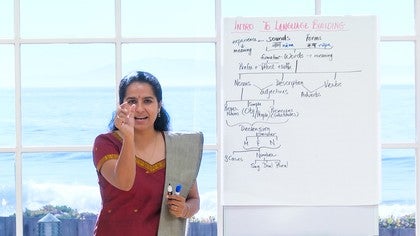Description
About This Video
Transcript
Read Full Transcript
Namaste dear friends and welcome back to the session on learning Sanskrit. Thus far we have looked in quite a great detail at the different sounds of the Sanskrit language which are the most fundamental building blocks of any language. We then went into the script of the sounds and therefore these are the very fundamental building bricks of any language. We'll just write it out. As you can see this is going to be an introduction to how the language builds itself.
So we started with the sounds. We had the sounds and then we had the forms which is the forms yeah. In Sanskrit there is a word for each of this so sounds is normally nama. I'm writing it out in Sanskrit so that you can start practicing what you have been learning with the letters and nama and rupa is form, rupa. Just notice that here when I write the r and it's a long oo it is like a little nine that gets put on its back there all right so that's the rupa so nama and rupa.
Now in most languages the single letters of the alphabet don't necessarily make sense. In the English language we have the the a which is pronounced as the er and which acts as an article. In Sanskrit however each of these sounds corresponds to a certain experience. So the sounds correspond to a certain experience and these experiences correspond to meaning. In most language what happens is when we combine sounds together then we form words.
And it is at this level of word formation that meaning normally is acquired. So words give rise to meaning. In Sanskrit as you can see it is sounds that give rise to meaning. So it's a level above that we can start having or rather the most simple parts of this language are also pregnant with a lot of sense. Now when we are talking of words we also start talking about word formations.
How do words form? Is it just the bringing of letters together that make a word? It is another deeper aspect to that. So in Sanskrit we all have root words so word formation. So how does a word form?
So we have a root form. That root form can get a prefix like in English you have progress. So very often this prefix pro can be identified with many words. It's like a prefix to that particular word. So prefix and then there is something like a suffix.
So you have a prefix, the root and the suffix. Now the words in any language can be divided into other categories. So words then form into nouns which are the names of different objects. So we have nouns, the other important category is the verbs, actions. So these are the objects and those are the actions.
But then we also have words which are descriptive. So there are some that describe the noun so I'll write descriptions. The words that describe the noun are the adjectives and the words that describe verbs become the adverbs. We can further categorize the nouns or sub-categorize the nouns. So nouns are of basically generally three kinds.
So we have proper nouns. So proper nouns are when you just have names like in India we have Ganesha, Rama or you can have Peter, Mary etc. or Kira and then we have objects that's the simple nouns. Simple ones, I'll just say simple here. So they can be objects or people and then we have the pronouns. So pronouns are substitutes for nouns so I'll just mention they are substitute nouns.
Now looking at these further we see that grammatically there's a term called declension. So as these words now start getting or start combining with each other and start relating to each other in the formation of sentence then they all undergo slight modifications. So for example the house of the girl it would become the girl's house. So that kind of a slight transformation of the noun or modification of the noun is known as declension. When talking of the different ways in which the different nouns are influenced we identified there are different factors that contribute to that.
Most important is the gender of the object so I'll make that, mention it. In Sanskrit we have three so we have the masculine, the feminine and the neuter. And another factor that plays an important role in determining the way the word transforms itself is the number. So here we have the number. Talking of numbers means that it can be either one person or two people or many or one thing, two things or many things.
So we have the three number categories in Sanskrit. So we have the singular, we have the dual and we have the plural. Now these nouns in Sanskrit always will have the gender, they will be associated with numbers so all the nouns will have the gender here, I should have written gender. They will have a number but there is another thing that is very characteristic of the Sanskrit language and also with languages like Latin or Greek or some of these classical languages. They are known as the cases, there are different cases.
We will look at each of these later on but it's just important for you to understand the entire context in which language builds itself. So here we have the cases and we have eight cases in the Sanskrit language. And what we mean by cases is in English for example when you say I go with my friend, the word friend does not undergo any change or I talk to my friend. The word friend remains identical but by adding the different prepositions we get an idea of what is happening to that friend. Is the friend the person to whom you are talking or is the friend somebody whom you are going with?
Now these prepositions get integrated into the word itself in the Sanskrit language. They become the suffix in the Sanskrit language. So when you have a word like, I'll just give you an example, the word like nara for man, that's the root. So when the man is, when the man is going it is nara, for example. Now if I am going with the man it will become narena.
So just to let you understand how the first part of it remains the same and it undergoes a slight modification afterwards to tell you which is the preposition that is getting linked to that particular word and those are the different cases. So we have eight cases, I'll just quickly run through them for you. So there is the subject case is the nominative or I'll just say subject. I'll keep it simple for now because we will look at these things in greater detail later on. We have the subject, then we have the object, then we have the instrument, etc.
I'll not get into all of it now. So we just know that there are eight cases like that. We have more or less completed the section on the nouns. Now let's move on to the descriptions. In Sanskrit what happens is that the adjectives take on all the forms of the nouns.
So since it is describing the noun it will play or rather it will take on all the extra masks that the noun take on. So that is an important connection to remember. Now going on to the verbs because that's the key in any language. If things can exist but if they are not doing anything, it doesn't make sense after that. So we have the verbs and when we are talking of verb changes, we call them the conjugations.
That is when the verb starts undergoing modifications to indicate a greater precision in who is performing it, how many are performing it and when they are performing it or how they are performing it. So when we are talking of conjugations, there are two things like I mentioned that become important. There is the agent or who is the doer of that action, agent or doer. Becomes important to determine that because that will change the way the verb acts. And then we have the tense, when.
So when talking of agents in the Sanskrit language, we have something like about nine possibilities generally. And when talking of the time, we have something like ten, tenses or moods. But what you need to remember at this stage is that for any verb, the question that is relevant is who is doing it, when are they doing it. It is at this stage that we can start connecting these two segments. Fortunately for the verbs, the gender does not matter.
Whether it's a man or a woman or a neuter thing doing it, the verb remains the same. But it does connect to whether it is singular, dual or plural. The other aspect of the verb talking of agent is who is doing it. So it connects to the noun form of it. So is it the person with, let's say, Peter or Mike or Mary or Kira doing the object or is it he or she or it.
So the agent corresponds to who is doing it, how many of them are doing it and when they are doing it. The adverbs describe the action and they would sometimes change according to that. Very often they are quite unchanging. The last category of words that I think exist are a bit a miscellaneous group. I'll just put it as a miscellaneous.
And they are words like and, but, or words like that are emphatic, indeed, things like that. So they are words of emphasize or fillers, if I may. I'll just put it like that for now. Fine. So this is how we are gradually and we have entered into the whole realm of grammar.
Grammar starts telling us not just how independent words exist, but how do they start combining with each other. What it is doing is it is helping us to start making sense of the world around us. How does this word connect with that word and what is the action that is linking the two of them? Et cetera, et cetera, et cetera. So grammar helps us to categorize our world in language.
And then in the last stage of any language building, once you have the whole set up, so when we have reached thus far, it is almost like you've got the whole scaffolding of a building up. You put in the bricks there, you build the walls, the entire structure is set. And now you get into the beautifications of it. You want to have a bedroom of one particular kind or the kitchen of a particular kind. That becomes or rather that aspect in language can be looked at the way in which we describe concepts.
So concepts are then expressed in different manners. So concepts can be expressed through prose, through poetry, through fiction, or any other things, et cetera. You can just have scientific knowledge, any kind of knowledge, fine. So I hope in this little way I have helped you sort of see how any language structure grows from the very building blocks to the way in which they are combined together, and then how many of these sentences combined together start giving us ideas and taking us on a real journey into the world around us. So there we are.
In Sanskrit, the power of the language starts with the little roots, master the roots, lay the foundations really strongly, and we can have a magnificent palace or a simple hut anywhere where you're comfortable to be in. But stay with me, and I'll take you through these different steps slowly at our own pace. Namaste.
Mother Tongue: Building Our Vocabulary
Comments

You need to be a subscriber to post a comment.
Please Log In or Create an Account to start your free trial.












